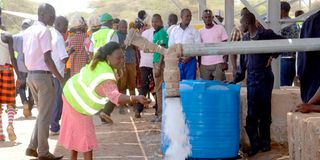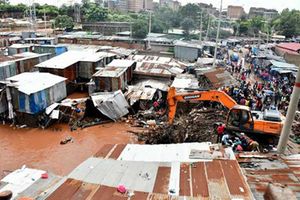Contamination of Turkana’s water aquifers alarming

Residents watch as water is pumped from a borehole at Napuu aquifer near Lodwar town in Turkana on January 21, 2024.
What you need to know:
- There is a growing concern by authorities over contamination of the aquifers that results from uncontrolled human activities.
- In Napuu village, about eight kilometres from Lodwar town, a rising number of permanent residential houses each with perimeter walls are phasing out manyatta structures that were sparsely constructed in the locality using indigenous trees.
Both Lotikipi and Napuu aquifers in Turkana County were discovered in water-stressed and sparsely populated villages a decade ago.
There were expectations that once exploited, the groundwater would not only address Kenya’s water needs for 70 years but first provide a solution to water scarcity in the two villages.
Collaborative efforts by both county and national government saw several boreholes drilled around Napuu aquifers for domestic use and irrigation, with excess water linked to the water supply system for Lodwar town.
However, there is a growing concern by authorities over contamination of the aquifers that results from uncontrolled human activities.
In Napuu village, about eight kilometres from Lodwar town, a rising number of permanent residential houses each with perimeter walls are phasing out manyatta structures that were sparsely constructed in the locality using indigenous trees.
The Water Resources Authority (WRA) and Turkana County government are now concerned about the aquifers’ vulnerability.
"Aquifer contamination due to human activities is increasing at an alarming rate. Areas with high concentration and intentional rigorous land use are particularly extremely vulnerable. Human activities are poisoning groundwater with toxic chemicals including nitrates from sewers that in turn affect the quality of water," WRA Regional Manager David Mutai said. Turkana Deputy Governor John Erus said pollutants released through human activities around the aquifer will automatically pollute the groundwater; and it will be extremely challenging and exorbitant to clean it up.
“The county government has stopped all land transactions until the ongoing land registration and regularisation process, which will identify areas like aquifers so that they are protected from encroachment, is completed," Dr Erus said.
He noted that the county government is collaborating with the national government through WRA and World Bank to implement Horn of Africa Groundwater for resilience programme that aims to increase the sustainable access and management of groundwater in borderlands.
"The county is prone to devastating effects of drought yet necessary stakeholders don't explore robust approaches to safeguard aquifers. With this, water scarcity will remain a challenge for many years to come," Dr Erus said.
He pointed out that groundwater constitutes a natural buffer against climate variability and change as it is available in times of drought when other surface or subsurface resources are scarce.
The programme, which is being implemented in five Arid and Semi Arid Lands counties namely Turkana, Marsabit, Mandera, Wajir and Garissa bordering Ethiopia and Somalia will benefit approximately 1.5 million people with several integrated projects comprising of water resource management, water services and sanitation services. The counties are within the North and North Eastern Development Initiative.



